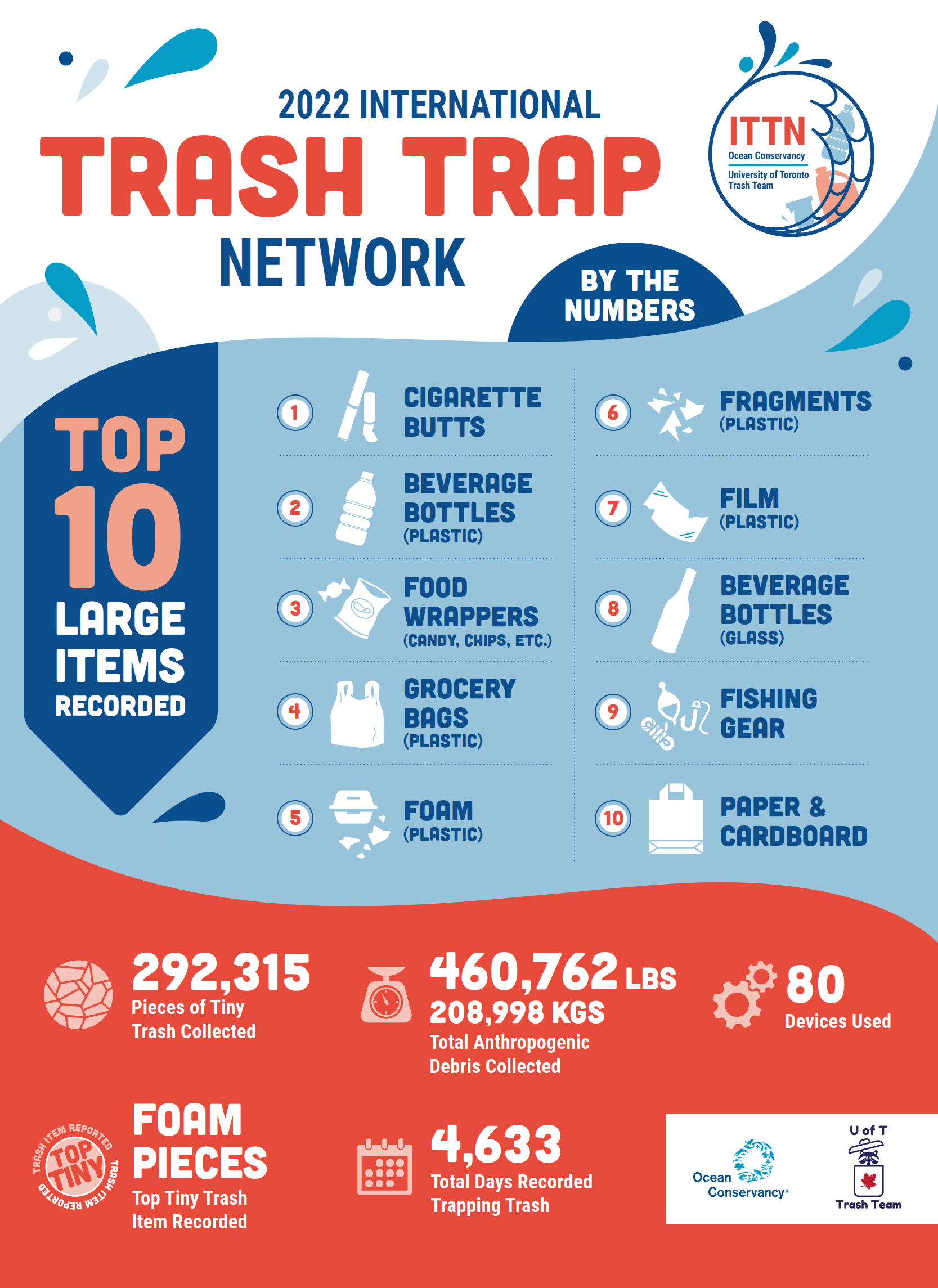International Trash Trap Network doubles in size, increases trash collection by over 6,000 times
The first-of-its-kind network of trash trapping devices releases 2022 cleanup results
TORONTO – Today, the International Trash Trap Network (ITTN), a first-of-its-kind collaboration between the University of Toronto Trash Team and Ocean Conservancy, released their 2022 data from a growing network of members using trash trapping technologies around the world to reduce plastic pollution.
In 2022, ITTN members reported diverting 460,761 pounds (209,998 kg) of human made debris of all sizes, nearly the weight of two blue whales. Comprising mostly of plastic pollution, this is more than 6,000 times the weight recorded in the previous year. The ITTN has nearly doubled the number of active members since its formation in March 2021, with 80 trash trapping technologies operating in 69 sites across Canada, the United States and Taiwan.
“This year’s ITTN data demonstrates how trash traps can be a valuable addition to community cleanup efforts,” said Hannah De Frond, coordinator for the ITTN. “Trash traps allow us to collect large amounts of plastic pollution from waterways, including microplastics which are extremely challenging to collect by hand; and collecting data on what these traps are diverting helps to inform local and global upstream solutions. It is fantastic to see how the network has grown in just two years, and we hope that more groups will join us to quantify our collective impact.”
The top waste item recorded were cigarette butts, which were found in almost every location. Other top items included plastic beverage bottles, plastic food wrappers, plastic grocery bags, pieces of plastic foam, hard plastic fragments and plastic film, glass beverage bottles, fishing gear, paper and cardboard. These are many of the same top items as Ocean Conservancy’s International Coastal Cleanup®, which mobilizes volunteers to clean beaches and waterways.
ITTN members also reported on microdebris (items smaller than a bottle cap), counting plastic as small as 2mm in size. In 2022, approximately 292,315 pieces of microdebris was recorded, almost double the amount collected in 2021. For the second year in a row, plastic foam pieces were the most common type of microdebris found.
Within the growing network, a wide variety of technologies are used, from well-known trash traps such as Seabins and Baltimore’s Trash Wheels, to drone technologies such as the Azure Fighter, engineered by Azure Alliance in Taiwan.
Scientists estimate that 11 million metric tons of plastics enter our ocean every year from land. Research co-authored by University of Toronto and Ocean Conservancy scientists found that to meet a target of less than 8 million metric tons of plastic entering the ocean by 2030, we need to do it all: reduce the amount of plastic being produced globally by 25-40%, manage 60-90% of plastic waste across all economies, and clean up on a massive scale, recovering at least 40% of annual plastic pollution emissions.
###
Infographics on the 2022 ITTN data can be found here.

About the International Trash Trap Network
The International Trash Trap Network (ITTN) is a collaboration between Ocean Conservancy and the U of T Trash Team, aiming to inspire groups around the world to trap trash locally, and to quantify this impact collectively as part of the International Coastal Cleanup®. The network’s goal is to increase the International Coastal Cleanup’s® annual cleanup efforts. They also aim to bring together local stakeholders to build trash trapping programs that will engage the community and collect valuable data to inform monitoring efforts and upstream solutions. For more information, visit trashtrapnetwork.org.
About The University of Toronto Trash Team
The U of T Trash Team, co-founded in 2017, is a science-based community outreach organization made up of undergraduate and graduate students, postdocs, researchers, local volunteers and staff all working together with a common goal to increase waste literacy in our community while reducing plastic pollution in our ecosystems. Their local projects use research to inform policy and management, and education and community outreach to increase waste literacy, engage the public and implement effective solutions. Their ultimate goal is to inspire an assortment of solutions resulting in the global reduction of waste and healthier habitats for wildlife and people. For more information, visit https://uofttrashteam.ca/ or follow them on Facebook, Twitter or Instagram.
About Ocean Conservancy
Ocean Conservancy is working to protect the ocean from today’s greatest global challenges. Together with their partners, Ocean Conservancy creates evidence-based solutions for a healthy ocean and the wildlife and communities that depend on it. For more information, visit https://oceanconservancy.org/, or follow them on Facebook, Twitter or Instagram.
Media Contact